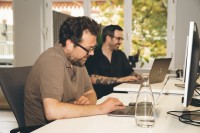Agencies in the Age of AI
200 Zeichen Lorem ipsum dolor sit amet, consectetuer adipiscing elit. Aenean commodo ligula eget dolor. Aenean massa. Cum sociis natoque penatibus et magnis dis parturient montes, nascetur ridiculus mus. Donec quu.
Kim Notz
05. November 2024
In March 2024, a quote from Sam Altman sent shockwaves through the agency world. The CEO of OpenAI predicted that 95 percent of what marketers currently rely on agencies, strategists, and creative professionals for will soon be handled by AI—easily, almost instantly, and at virtually no cost. According to Altman, AI will even test creative work with real or synthetic focus groups to predict and optimize results. Again, all free, immediate, and nearly flawless. Images, videos, campaign ideas? No problem.
Perhaps even more unsettling is the timeline: Altman expects this shift to happen in about five years—one of which has almost already passed since his statement. That leaves roughly four years to prepare for this transformation. Even if the timeline proves optimistic, or the eventual figure lands at 90 or 85 percent, the industry largely agrees: AI adoption is inevitable, and there has never been a better time to start experimenting and learning.
Lorem ipsum dolor sit amet, adipiscing elit.
Like any foundational technology, AI is set to profoundly transform agency products, workflows, and the value they create. Those of us who have been around a while will remember how digitalization first revolutionized print, then radio, and eventually TV. Much of what used to be done by hand became partially or fully automated. With increasing connectivity, new channels and formats emerged, automation accelerated further, and with it, the pace of change.
For years now, a wave of automation has been sweeping through asset production. For many agencies, producing countless formats and adaptations for different channels, campaigns, and points of sale has been bread and butter. Hyper-personalization in the digital realm has already given rise to highly automated systems—against which traditional asset production seems as quaint as a medieval scriptorium before the invention of the printing press.
The crucial question for agencies
This business is at risk. If past technological leaps are any guide, it won’t disappear entirely—but it will change profoundly. The critical question for agencies is whether the share of creativity in their business will grow. If everything that can be automated is automated, what will be left for us to do? Tasks that are (still) non-automatable—such as developing, maintaining, and managing these systems—remain. Which of these tasks agencies can or want to take on is a question we must answer ourselves.
What makes Altman’s statement so unsettling are the implications for the core strategic and creative work—the very heart of the agency business. If even that work becomes largely automatable, the very existence of the industry is at stake. Or, put differently: what are the five percent of our work that even a die-hard AI optimist couldn’t hand over to AI?
The answer will likely emerge layer by layer, like peeling an onion: gradually automating the outer layers. At the same time, it’s essential to explore the new opportunities AI brings to advertising. Advertising agencies existed long before radio, TV, or the internet were invented. To navigate this new landscape, we not only need to test new tools but also adapt existing workflows—or even define entirely new workflows and products.
Lorem ipsum dolor sit amet, adipiscing elit.
Jasper Börnsen explained how this works in the day-to-day of a social-first agency in episode #125. He is the Innovation and Marketing Lead at Justaddsugar. Founded in 2018, the agency started out in motion-picture production with a focus on social media. From there, it has moved vertically through the value chain, taking on distribution and production as well as strategy and creative work.
Two percent of the original resources
Distribution across digital media and the production of partially highly personalized assets are already heavily automated today. AI is set to accelerate this process further and will also play an increasing role in creative work. For now, Jasper still sees Justaddsugar’s core business—video production—as secure. However, a test in the Innovation Lab he leads yielded some intriguing insights.
The goal was to recreate a video previously produced by the agency for a client’s automotive product launch using purely generative AI, without relying on any original production material. By using tools like Runway, MidJourney, and Stable Diffusion, they managed to achieve the task with only two percent of the original resources—but in terms of detail and polish, they couldn’t match the quality of the original. Nevertheless, the dramatic productivity gains demonstrate the potential of generative AI once quality catches up.
With this approach, Jasper’s team continuously tests AI tools for their practical applicability. Much of what they try shines at first glance but ultimately isn’t “gold.” Tools like that shouldn’t even make it into the organization. Only what sustainably improves processes and can be applied directly to client projects graduates from the Innovation Lab into everyday agency work.
ComfyUI is particularly helpful in this context—a user interface designed so that not just AI engineers can use it. ComfyUI works like a flowchart, mapping out different steps to automate recurring tasks, from format conversions to the creation of entire visual worlds. Crucially for agencies, it respects the Look & Feel defined in the branding guide.
For a motion-focused agency like Justaddsugar, this opens up the potential to extend the value chain toward the lower funnel. Here, fewer videos but many stills are needed—still aligned with the upper-funnel motion content. This phase is more about conversion, which in turn drives the demand for new types of content, creating entirely new fields of work for the agency
A Mixed Picture on the Client Side
On the client side, the picture is mixed when it comes to openness toward AI. Cost pressures and the expectation of potential savings often collide with ethical concerns, data protection, and internal policies that may restrict its use. Some clients aim for a 100-percent solution, which effectively prevents any experimentation, while others are willing to test and learn.
In this context, knowledge sharing within the agency world is crucial: sharing what solutions have already been tested, what worked well, and what didn’t. It’s about innovation—both for the agencies themselves, their tools, workflows, processes, and products, and ultimately for their business models. Agencies also have a responsibility to prepare and guide their people on this journey.
Lorem ipsum dolor sit amet, adipiscing elit.
It’s perfectly fine that not everyone in the agency gets immediately excited about every new tool. That’s exactly what teams like Jasper’s Innovation Lab are for—they dive deep, identify the key drivers in each area, create moments of success, and inspire others along the way.
The features a new tool offers are just one part of the equation. Equally important is finding the right place for it in the value chain, which in turn may evolve as a result. It’s not enough to dream up innovations in the lab; we also need to bring them back into the individual crafts and work alongside the teams to implement them operationally.
Find more here:
Kontakt





